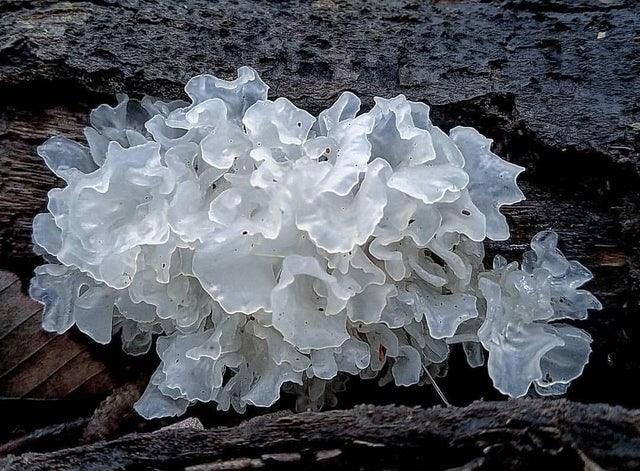
Sparassis Crispa, or Cauliflower Mushroom as it is commonly known, is an edible brown root fungus that grows primarily on the stumps of coniferous trees.
It is widely distributed throughout the Northern Temperate zone, and so is found in many countries throughout the world.
This mushroom has a thin, paper-like texture with a slightly sweet-earthy taste.
While having been used in cooking for centuries, typically in Asian cuisine, it is now receiving worldwide attention as more than just a meal ingredient.
Traditional medicine has sworn to its healing properties. Over the past 30 years, scientific and medical research carried out predominantly in Japan, China and Korea (and more recently in the USA) has revealed the unique and potent compounds found in this mushroom. Let’s take a look inside…
Sparassis Crispa Active Ingredients
Besides protein, carbohydrates and fibre, genome sequencing has revealed an abundance of bioactive compounds(i) (ii):
- Phthalides
- Monosaccharides, Disaccharides, Polysaccharides (xylose, fructose, mannose, glucose, trehalose, beta-glucan)
- Anti-fungal/microbial components (sparassol, methyl2,4-dihydroxy-6-methylbenzoate and methyl-dihydroxy methoxy-methylbenzoate)
- Benzoate acid derivatives (veratric acid)
- Amino Acids (glutamine, tryptophan and aspartic acid)
- Vitamins (C, D2 and E)
- Minerals (Potassium, phosphorus, sodium, and magnesium)
- Enzymes (esterase, cellulase, lignin peroxidase, glucosyl ceramide)
- Sterols (ergosterol)
Sparassis Crispa & the Skin
The function and appearance of the skin are mediated primarily by the structure of two major layers, the epidermis and dermis. The outer barrier of the epidermis results from the differentiation of keratinocytes (cells). In the dermis you find fibroblasts which predominantly produce ECM (the skin matrix). ECM is composed of collagen, elastic fibres, and proteoglycans (protein cell).
Fibroblasts maintain the structural integrity of connective tissues by not only forming it, but by maintaining (healing) the tissue.
Focusing on two compounds in particular, scientific research has shown what these do for our skin’s health and repair (and indeed our entire body).
Beta-Glucans are a soluble dietary fibre naturally occurring in the cell walls of cereals, bacteria, and fungi. The cauliflower mushroom has 40% β-glucan content when dried, the highest out of any fungus. Classically they’ve been used to boost the immune system and to treat high lipids (cholesterol). When it comes to skin and beauty, tests are showing accelerated wound healing and hydration. One of the less advertised benefits is a cure for stroke patients due to the lowering of blood pressure and anti-clotting effects.
Veratric Acid is a phenolic compound derived from vegetables and fruits which has been reported to have anti-inflammatory, anti-oxidant, antibacterial, antifungal and photo-protective effects.
Increases Skin Wound Healing
Research conducted on rats and human skin cells alike, have shown the beta-glucan in Sparassis Crispa to accelerate the healing of skin wounds(iii).
It does this by signalling fibroblast skin cells to move to the affected area and produce collagen.
Reduces Skin Dehydration
The oral intake of Sparassis Crispa in adults was investigated for 4 weeks against a placebo group. It was found that cheek transepidermal water loss was significantly lower in the experimental group than in the control group, showing better skin condition and moisture(iii).
Increases & Restores Collagen synthesis
The levels of type I collagen synthesized by cultured human dermal fibroblasts for the Sparassis Crispa beta-glucan group were significantly higher than those for the control group, after a 4 week trial(iii).
To investigate the effect of Cauliflower Mushroom Veratric Acid on type I procollagen, UVB irradiated dermal fibroblasts were evaluated in a laboratory. Treated fibroblasts showed a significantly restored secretion of type I procollagen when compared to untreated damaged fibroblasts(iv).
Reduces UV Skin Damage
Veratric Acid was laboratory tests against UV-irradiated keratinocytes. There was a marked reduction in DNA damage and inflammation in keratinocytes(v).
In a separate study, human cells were treated with different concentrations of Veratric Acid after being exposed to UVB. The results showed a reduced amount of DNA damage compared to cells not treated with Veratric Acid. Not only that, the findings found that Veratric Acid allowed more time for the cellular repair of DNA damage, and stopped the spread of the damaged cells(vi).
Further to this, there is extensive research showing that the compounds in this mushroom have phenomenal pharmacological activities inside our bodies:
tumour suppression(vii-ix), cancer prevention(x), enhancement of natural killer cell activity (viii), anti-angiogenic effects(ix) – tumours can’t grow own blood vessels, anti-allergic effects(xi), anti-diabetic effects(xii), platelet anti-aggregation(xiii) – prevents blood clots, anti-hypertensive effects(xiv), and enhancement of hematopoietic responses(xv) – blood self-renewal.
Why would you NOT want all these benefits?
My Beauty Luv’s incredible vegan Beauty Blast is crammed full of Cauliflower mushroom.
We use the whole fruiting body of the fungus - freeze-dried and powdered – you can rest assured that you are getting 100% purity.
- Kimura, T. (2013). Natural Products and Biological Activity of the Pharmacologically Active Cauliflower MushroomSparassis crispa. BioMed Research International, 2013.
- Kiyama, R., Furutani, Y., Kawaguchi, K., & Nakanishi, T. (2018). Genome sequence of the cauliflower mushroom Sparassis crispa (Hanabiratake) and its association with beneficial usage. Scientific Reports, 8(1).doi:10.1038/s41598-018-34415-6
- KIMURA, T., HASHIMOTO, M., YAMADA, M., & NISHIKAWA, Y. (2013). Sparassis crispa(Hanabiratake) Ameliorates Skin Conditions in Rats and Humans. Bioscience, Biotechnology, and Biochemistry, 77(9), 1961-1963(2013).doi:10.1271/bbb.130185
- Lee, K.-E., Park, J.-E., Jung, E., Ryu, J., Kim, Y. J., Youm, J.-K., & Kang, S. (2016). A study of facial wrinkles improvement effect of veratric acid from cauliflower mushroom through photo-protective mechanisms against UVB irradiation. Archives of Dermatological Research, 308(3), 183–192.
- SW, Jung E, Kim S et al (2013) Antagonist effects of veratric acid against UVB-induced cell damages. Molecules 18:5405–5419
- Shin, S., Jung, E., Kim, S., Lee, K.-E., Youm, J.-K., & Park, D. (2013). Antagonist Effects of Veratric Acid against UVB-Induced Cell Damages. Molecules, 18(5), 5405–5419.doi:10.3390/molecules18055405
- Ohno N, Miura NN, Nakajima M, and Yadomae T, Pharm. Bull., 23, 866-872 (2000).
- Hasegawa A, Yamada M, Dombo M, Fukushima R, Matsuura N, and Sugitachi A, Gan to Kagaku Ryoho, 31, 1761-1763 (2004).
- Yamamoto K, Kimura T, Sugitachi A, and Matsuura N, Pharm. Bull., 32, 259-263 (2009).
- Yoshikawa K, Kokudo N, Hashimoto T, Yamamoto K, Inose T, and Kimura T, Pharm. Bull., 33, 1355-1359 (2010).
- Yao M, Yamamoto K, Kimura T, and Dombo M, Food Sci. Technol. Res., 14, 589-594 (2008).
- Yamamoto K and Kimura T, Health Sci., 56, 541-546 (2010).
- Hyun KW, Jeong SC, Lee DH, Park JS, and Lee JS, Peptides, 27, 1173-1178 (2006).
- Yoshitomi H, Iwaoka E, Kubo M, Shibata M, and Gao MB, Nay. Med., 65, 135-141 (2011).
- Harada T, Miura N, Adachi Y, Nakajima M, Yamomae T, and Ohno N, Pharm. Bull., 25, 931-939 (2002).





